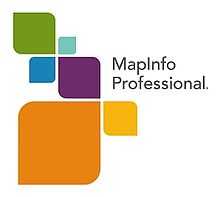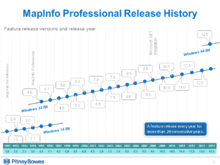MapInfo Professional
 | |
| Developer(s) | Pitney Bowes Software (formerly MapInfo Corporation) |
|---|---|
| Initial release | 1986 |
| Stable release | 12.5 / July 2014 |
| Operating system | Windows |
| Available in | 18 languages |
|
List of languages Multilingual
| |
| Type | Geographic information system |
| License | Proprietary |
| Website |
www |
MapInfo Professional is a desktop geographic information system (GIS) software product produced by Pitney Bowes Software (formerly MapInfo Corporation) and used for mapping and location analytics. MapInfo allows users to visualise, analyse, edit, interpret, understand and output data to reveal relationships, patterns, and trends. MapInfo allows users to explore spatial data within a dataset, symbolize features, and create maps.
History

MapInfo Professional was first released in 1986 as the Mapping Display and Analysis System (MIDAS) and was the first desktop GIS product on the market. At this time it was available only for the DOS operating system. This software could be customized by using the MapCode development environment which was a C-like programming language. The name was subsequently changed to just "MapInfo" upon its second release.
The DOS product was eventually discontinued and replaced by MapInfo for Microsoft Windows in 1990. MapInfo was redesigned with an easier-to-use graphical user interface and was also made available for the UNIX and Macintosh operating systems. The MapCode development environment was replaced with a new language called MapBasic.
Version 4 of the product, released in 1995, saw the product renamed to "MapInfo Professional".[1]
Version 9.5 was released in June 2008. Version 9.5.1 was released in December 2008. The primary enhancements in these releases included the use of a new graphics engine which allows for translucency and anti-aliasing when displaying maps. A set of CAD like editing tools were also added in this release.
Version 10 was released in June 2009. The primary enhancements included a more intuitive user interface, including a rewritten Layer Control dialog box, compatibility with PostGIS and a PDF generator that supports both Layered and georeference PDF files.
Version 10.5 was released in May 2010. The primary enhancements included a new Table Manager window, a built in ability to publish to MapInfo Stratus, ability to ingest Bing Maps directly as background mapping and enhanced support for Catalog Service for the Web (CSW).
Version 11 was released in June 2011. The primary enhancement included performance tuning and usability improvements on the Browser window for creating and analysing tabular data. Integration with MapInfo Manager, a product for managing spatial data and providing [INSPIRE] compliance. Support for 64 bit operating systems was improved with the ability to use up to 4 GB of RAM (instead of 2GB, the limit when running on 32 bit operating systems).
Version 11.5 was released in June 2012. The primary enhancements include a new window for Creating Legends, further enhancements to the new Browser window (introduced in v11.0) and further integration with MapInfo Manager, including the ability to edit metadata within the Catalog Browser.
Version 12 was released in June 2013, with improvements to Cartographic Output; Support for Windows 8, SQL Server 2012, PostGIS2; and a new In-Product Notifications feature utilizing RSS.
Version 12.5 was released in July of 2014.
Uses
MapInfo Professional is used by proficient GIS users or analysts for complex spatial analysis, building reports that describe their conclusions, and making decisions based on those conclusions. It is used for a wide range of business applications in many industries.
With MapInfo Professional, the Sydney Organizing Committee for the Olympic Games (SOCOG) created hundreds of maps for the longest torch relay in the history of the modern games. The Olympic Torch Relay covered 16,740 miles in 100 days and traversed Australia by road, railway and boat. The torch route was designed to ensure that more than 85 percent of the Australian population was within a one-hour drive of the chosen route, which passed through 1,000 towns. In addition, TNT Express used MapInfo to map more than 5,500 delivery routes to deliver Olympic tickets to more than 400,000 Australian homes. “We couldn’t have created the torchbearer selection process without MapInfo and CDATA96, and it was invaluable as a backup for picking up discrepancies in the information in our database…”[2]
Other examples include:
- Map Creation and Editing - MapInfo Professional includes map creation and editing tools including the ability to auto-trace over complex regions; create any parcel region including a diamond shape (or any parallelogram); map rotation; object rotation; copy, move or “nudge”; “Snap-to” nodes automatically follow common boundaries or geographical features.
- GeoMarketing - The application of location intelligence to identify geographic areas in which to deliver marketing.
- Site Location Analysis - Determining the optimum location to open or close a site e.g. store, factory, depot etc. The selection process is typically based on customers or worker location, demographics, buying patterns, transport links, nearby facilities.
- Crime Analysis - Systematic analysis of spatial data for identifying and analyzing patterns and trends in crime and disorder.
Features
- Layering: One of the most frequently used features of MapInfo Professional is its ability to combine data from widely different sources, even with different formats and projections, in the same map window. Once combined in the map window, relationships that only exist geographically between the different data sets can be visualised and queried. Layers can be vector and raster together. In the map window, you can control the order of layers, labelling and display characteristics including the translucency of raster images.
- Thematic Mapping: Allows the user to shade maps, present bar & pie charts, graduated symbols, dot density, and grids. In addition, the Prism thematic feature that allows regions of the map to be extruded to give the impression of height.
- SQL Selection with Geographic Extensions: Build and save SQL queries that access and integrate data from multiple tables. Frequently performed queries can be written once, re-used and distributed to others. Standard SQL statements include SELECT, FROM, WHERE, GROUP BY, ORDER BY, and INTO, and geographic specific SQL statements include CONTAINS, WITHIN, PARTLY WITHIN, ENTIRELY WITHIN, and INTERSECTS. Results can be aggregated using SUM(), MIN(), MAX(), COUNT(*), AVG(), and WTAVG() functions. Once a selection is made, it can be inverted because crafting a complex query to select all but a few records or objects, is often more easily achieved by select the few to exclude, and invert the selection to unselect them and simultaneously select all the others.
- Charts & Graphs: Interactive graphs and charts including 3D, bubble, column, histogram, surface, area, bar, line and pie scatter charts. Select graph templates from thumbnail sketches. Graphing style control includes position, tilt, rotation and pie explosion. Choose database records by clicking on sections of a chart or graph.
- Hotlinks: Any object in a map can now contain a link to a document (URL, .doc, .xls, .ppt, .tab, .wor, .mdb, etc.) that will automatically launch when clicked.
- 3D Visualization: 3D viewing allows for freehand tilt and rotations of maps as well as for traditional panning and zooming.
- Raster Image Support: Use raster images such as scanned paper maps, satellite images, photographs and logos to provide detailed content layers for your maps.
- Linked Views: View and/or edit data in multiple linked views (including rows and columns, graphs and maps) simultaneously.
- Buffers Around Objects: Perform detailed geographic searches with buffering and area selection tools.
- Geographic Searches: Integrate geographic criteria into database queries (contains, intersects, within, etc.).
- Drag and Drop Tool: Improve presentations by "dragging and dropping" a map into other applications such as Microsoft® Word, Excel and PowerPoint and Corel Draw or export maps directly into PhotoShop.
- Crystal Reports: Use the built-in report writer from Crystal Reports to provide additional support for your visual analysis.
- Conflict Management: Manage discrepancies in data when multiple users write to server based data files.
- Universal Translator: Translate bi-directional between MapInfo Professional and other mapping environments including AutoCAD, ESRI and Intergraph/Bentley. Formats include DWG, DXF, DGN, Shape and E00 and so on.
- Rotate Map Window Utility: Rotate the map window a specific number of degrees.
- Easy Loader: Upload MapInfo TAB files into database.
See also
- MapBasic
- MapInfo TAB format
- List of GIS software
References
- ↑ MapInfo vs. Arc/Info Comparison
- ↑ Burnett, Ant. "SOGOC torch relay mapping and IT specialist". MapInfo Annual Report 2000. Retrieved 5 September 2012.